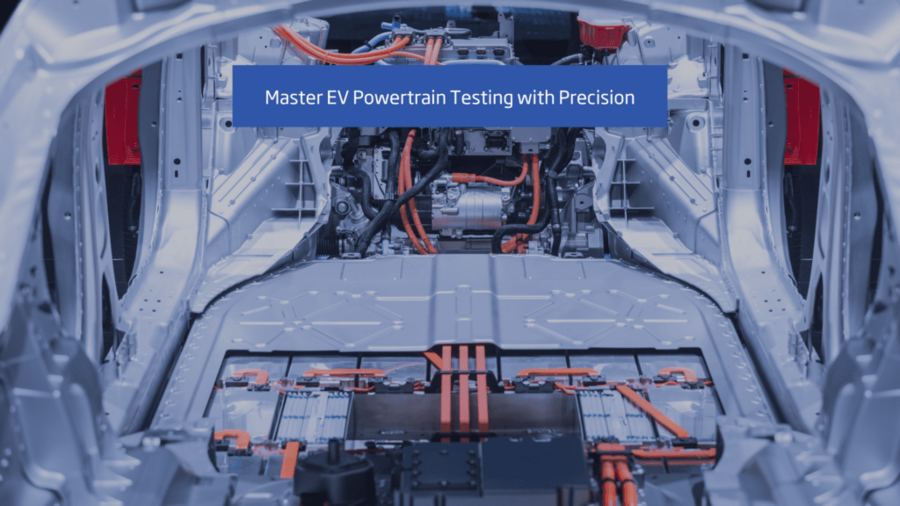Technical Challenges in EV Powertrain Testing and Power Quality Measurement
EV Powertrain Testing Challenges
- Battery
Battery testing challenges involve ensuring capacity, efficiency, and performance under various operating conditions. This requires simulating different temperatures, charge-discharge cycles, and state-of-charge (SOC) levels. Additionally, battery aging and degradation testing is crucial to ensure the long-term reliability and safety of the battery. - Inverter
Inverter testing challenges include ensuring proper motor control, assessing efficiency, and verifying the inverter’s ability to handle different load conditions. Testing the inverter’s thermal performance, protection features, and fault handling is also vital to ensure the overall reliability and safety of the powertrain. - Motor
Motor testing challenges include assessing its efficiency, torque, and power output over a wide range of speeds and load conditions. Testing the motor’s cooling system, noise, vibration, and harshness (NVH) characteristics is crucial to ensure a smooth and comfortable driving experience.
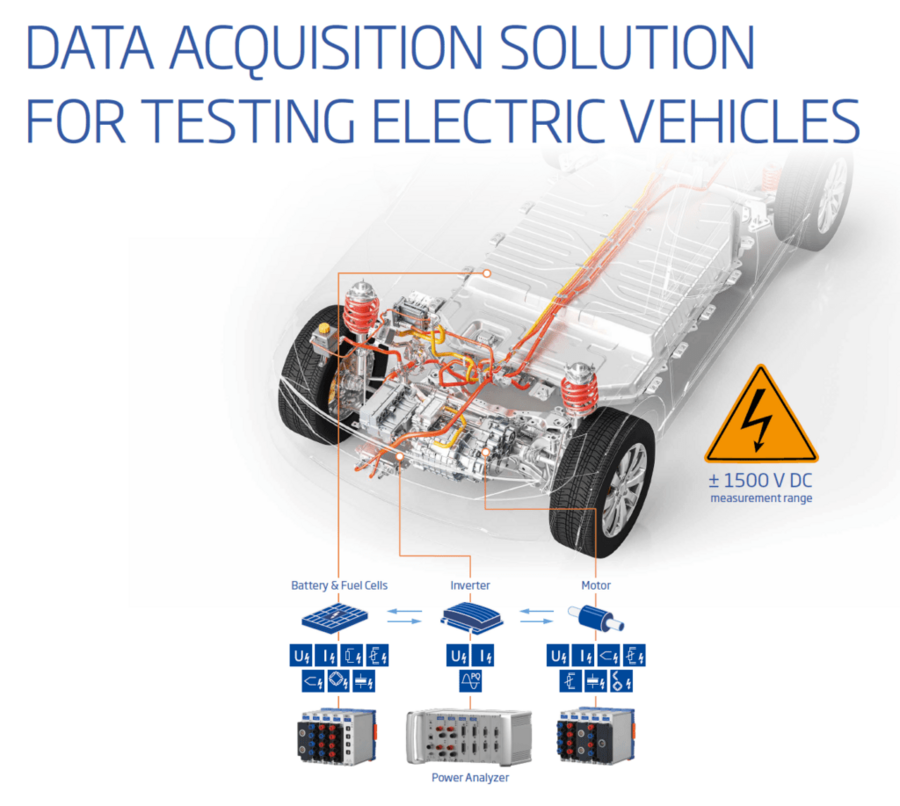
Appropriate Measurement Frequency in EV Powertrain Testing
The measurement frequency for EV powertrain testing depends on the specific component being tested and the parameters under examination. Engineers often use a combination of high-speed data acquisition systems and lower-frequency monitoring to balance the need for accurate, high-resolution data with manageable data volumes.
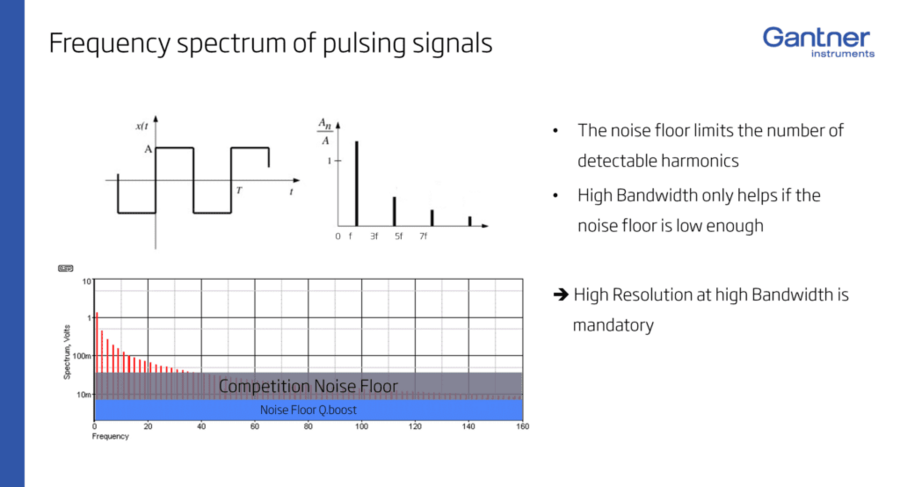
Power Quality Measurement Challenges
- Harmonics and interharmonics
Electric vehicles introduce harmonics and interharmonics into the power system due to their non-linear components, such as converters and inverters. These distortions can cause interference, overheating, and malfunctions in sensitive equipment, ultimately affecting the overall power quality. Accurately measuring and analyzing harmonic and interharmonic content is crucial for identifying potential issues and optimizing power quality. - Voltage fluctuations and flicker
EV charging stations, regenerative braking systems, and rapid load changes can cause voltage fluctuations and flicker in the power network. These variations can lead to instability in the power system, causing equipment malfunction or failure. Engineers must carefully monitor and measure voltage fluctuations to maintain the required power quality standards. - Transient disturbances
High-frequency transient disturbances, such as voltage spikes or dips, can result from switching operations, fault conditions, or lightning strikes. These disturbances can cause severe damage to electronic components and affect the reliability of the powertrain system. Identifying and mitigating transient disturbances is essential for maintaining power quality and ensuring the safe operation of automotive systems. - Unbalance and asymmetry
Power systems in electric vehicles may experience unbalance and asymmetry due to uneven load distribution or unequal impedance values in the system components. These conditions can lead to increased losses, reduced efficiency, and potential damage to equipment. Engineers must measure and analyze the unbalance and asymmetry in power systems to optimize power quality and ensure the longevity of the components. - Reactive power and power factor
Reactive power and power factor are crucial parameters in assessing the efficiency of power systems. In electric vehicles, reactive power can be generated by inductive and capacitive loads, such as motors and converters. A poor power factor can result in increased energy losses and reduced system efficiency. Accurate measurement and analysis of reactive power and power factor are necessary to optimize the power system’s performance and minimize energy waste.
The technical challenges of power quality measurement are significant, requiring advanced measurement tools and techniques to ensure optimal performance and efficiency. Next, we will discuss how Gantner Instruments’ Q.boost Power Analyzer can address these challenges, providing accurate and high-resolution data to better analyze and optimize power quality in automotive applications.
Our Solution To Technical Challenges in EV Powertrain Testing
GPA100 Power Analyzer
The GPA Series integrates seamlessly into e-drive test beds for extensive testing of inverters and entire powertrains, facilitated by its EtherCAT interface, which enhances compatibility with modern testing frameworks. The GPA100 measures and analyzes voltage and current signals in three-phase systems, such as electric drives, and evaluates critical power quality parameters including harmonics, interharmonics, voltage fluctuations, transient disturbances, unbalance, and power factor. Additional functionalities include inputs for DC voltage, DC current, torque, and speed meters, extending its utility to the testing of highly integrated e-axles, with options for quality checks and end-of-line analyses. These capabilities ensure that every component of the powertrain is optimized for performance and reliability.
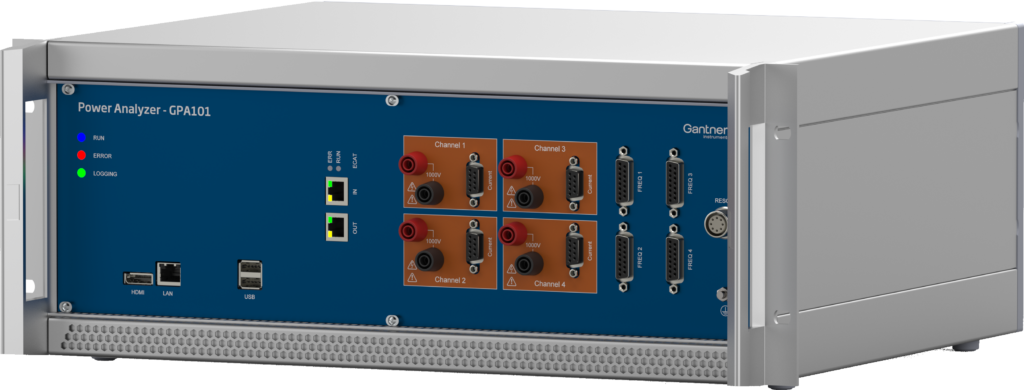
Key Components of the Power Analyzer GPA100
- High Voltage and Current Measurement: With up to four high-voltage input channels and four inputs for current transducers (e.g., LEM IT, IN, LF series, from Danisens), and a built-in bipolar power supply system, the GPA100 Power Analyzer streamlines your EV powertrain testing and power quality measurement processes.
- Advanced Signal Processing: A high sampling rate of 4 MHz per channel and a bandwidth up to 1.7 MHz allow for precise capture and analysis of fast-transient signals within the powertrain.
- Integrated Data Handling: The GPA100 features a built-in resolver for analyzing highly integrated e-axles and options for quality and end-of-line checks, enhancing the analyzer’s utility in production settings.
- Streamlined Testing Process: The built-in bipolar power supply system for current transducers eliminates the need for additional power supply systems and wiring, simplifying the testing and measurement process.
- Flexible Integration and Data Transmission: The EtherCAT interface, coupled with compatibility with CAN Bus systems, ensures the GPA100 integrates smoothly into existing test setups and facilitates efficient data sharing.
- Comprehensive Power Quality Analysis: Capabilities to assess power quality parameters like harmonics, voltage fluctuations, and transient disturbances help maintain the integrity and reliability of the EV’s powertrain.
Unique Features of the Gantner Power Analyzer (GPA) Series
Superior Noise Performance
The GPA100’s advanced design achieves a noise floor significantly below –140dB, allowing for the accurate detection of subtle disturbances and harmonics necessary for determining the efficiency of power systems. This exceptionally low noise floor ensures data integrity, which is critical for applications requiring high-fidelity signal analysis.
Total Harmonic Distortion (THD)
With a THD at less than 3 parts per million (ppm), the GPA100 significantly outperforms other devices in its class. These precise analog inputs are vital for applications where understanding the quality of power and its impact on system performance and durability is crucial.
Robust Power Analysis Capabilities
The GPA100 supports a wide range of measurements, including power, power factor, THD, and efficiency, all delivered in real-time via EtherCAT. The device is also equipped with a robust data logger and capabilities for high-speed signal capture up to 4 MHz per channel, offering engineers detailed insights into both transient and steady-state conditions.
Form Factor and Integration
The GPA100 Power Analyzer is available in a 19” rack (4U) housing and works seamlessly with the GI.bench software. The system provides two inputs for frequency measurement, making it easy to connect torque sensors with frequency outputs and two counter inputs for speed sensors (tachometers). The raw voltage and current values are always accessible through EtherCAT and our open API.
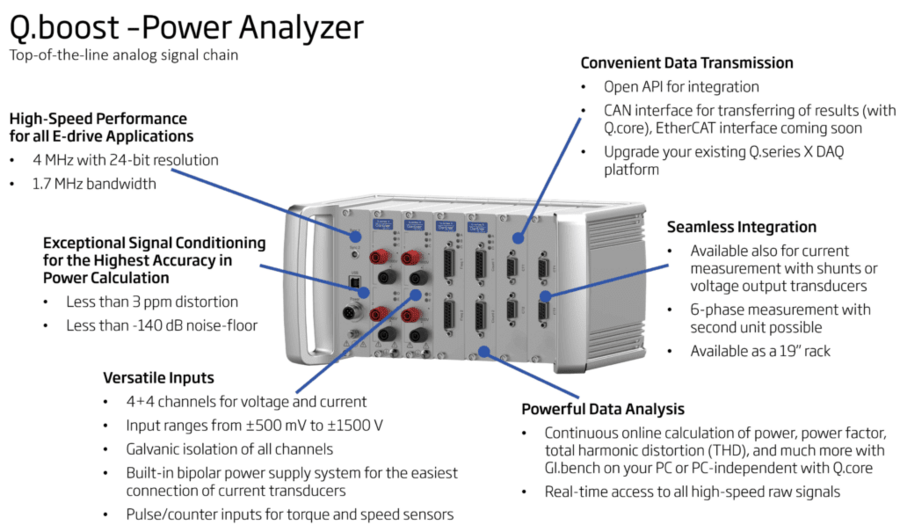
The GPA100 is an advanced solution that addresses the challenges in EV powertrain testing and power quality measurement in the automotive industry. It provides engineers with accurate and high-resolution data for better analysis, system optimization, and power quality management. With its impressive features and performance, the GPA100 is an essential tool for engineers working on EV powertrain testing and power quality measurement.
Q.series X: High-voltage Isolation Measurement Modules for Automotive Testing
Gantner Instruments’ bestselling data acquisition product line, Q.series X, includes high-voltage isolation measurement modules with precise and stable signal conditioning and safe electrical isolation up to 5000 VDC peak and 1500 VDC continuously. The modules support various measurement inputs for voltage, current, RTD, thermocouple, IEPE, and strain gage sensors with data sampling up to 100 kHz. Some of the benefits of the Q.series X for Automotive Testing include:
- Flexible Mixed-Signal Data Acquisition
The Q.series X is a mixed-signal, multi-channel data acquisition solution offering a versatile range of I/O modules. You can measure voltage, current, temperature, torque, strain, vibration, counters, and more. With this maximum sensor flexibility, the DAQ system can be easily adapted to the demanding requirements of EV powertrain testing. - 1500V High-Voltage Galvanic Isolation
Q.series X high-voltage isolation measurement modules are suitable for voltage, current, RTD, thermocouple, IEPE, and strain gage sensors sampling up to 100 kHz. All high-voltage isolation modules include a minimum of 1500 VDC channel-to-channel, channel-to-supply, and channel-to-bus galvanic isolation. - High-Accuracy Thermocouple Measurement
Temperature is a key measurement for improving battery and overall electric powertrain efficiency. Clever input circuits and high-voltage galvanic isolation ensure the highest accuracy in any test environment. - Fully Configurable Data Loggers
Engine testing generates a lot of data with varying sample rates. Mixed-signal, multi-frequency data logging ensures only the data you need is saved, avoiding unnecessary data storage overhead. - Easy Integration
Easy-to-use APIs, modern publish-subscribe protocols, and various Fieldbus interfaces, like CAN, EtherCAT, and PROFINET, make it simple and easy to integrate the Q.series X into any supervisory control and data acquisition system. Plugins & drivers for LabVIEW, MATLAB, and Python, among others, enable advanced data analysis and reporting.
Inline dynamic switching between resting current and operating current
Measuring the standby current of a battery is crucial for ensuring its safe and efficient operation. The battery’s capacity and lifespan can be optimized by identifying issues such as self-discharge or parasitic loads. To accurately measure the standby current, a Battery Management System (BMS) is required to switch dynamically between resting and operating current without interrupting the power supply to the device under test. This inline dynamic switching capability ensures precise and continuous measurement of the standby current, providing valuable insights into the battery’s performance and health.
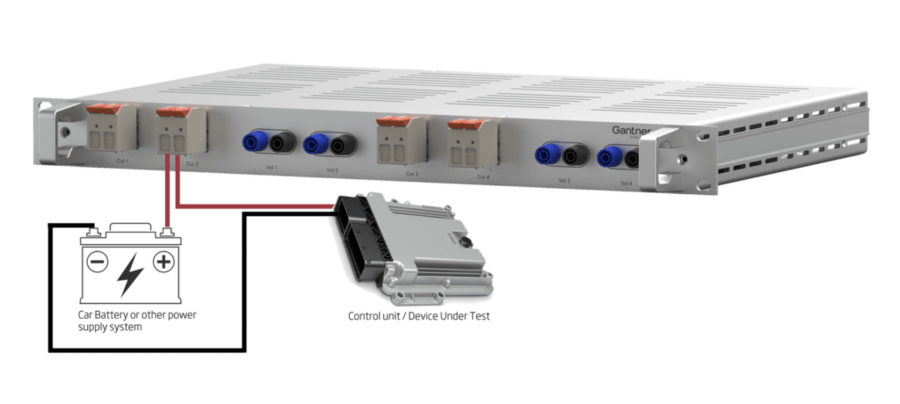
By using Gantner Instruments’ DAQ solutions, engineers can gain insights into the battery’s standby current and identify potential issues that could affect the overall performance, safety, and lifespan of the battery. These insights are invaluable for making informed decisions and optimizing battery systems in the automotive and electric vehicle industries.
GI.bench and GI.connectivity: Streamlined Configuration and Connectivity
GI.bench is a powerful software tool for configuring and managing Gantner Instruments’ Q.series X data acquisition systems. GI.connectivity enables seamless integration of Q.series X with third-party software and bus systems, ensuring smooth operation and data flow in your testing environment. Some advantages of using GI.bench and GI.connectivity include:
- User-friendly interface
GI.bench offers an intuitive interface, making it easy to configure and manage Q.series X systems. - Comprehensive data management
GI.bench allows users to visualize, analyze, and store acquired data for further processing and reporting. - Open API
GI.connectivity provides an open API, allowing for easy integration with third-party software and various Fieldbus interfaces such as CAN, EtherCAT, and PROFINET.
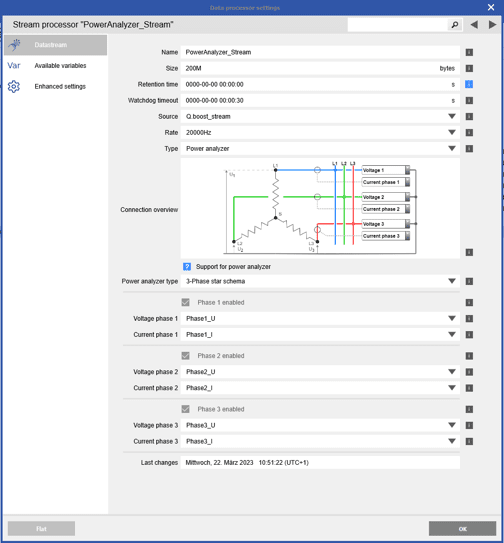
The technical challenges in EV Powertrain Testing and Power Quality Measurement are significant, but Gantner Instruments’ innovative solutions, such as the Q.boost Power Analyzer and Q.series X, offer engineers the tools they need to overcome these challenges. With high-resolution data, accurate measurements, streamlined testing processes, and easy integration, Gantner Instruments’ products and services provide significant advantages to technical engineering professionals in the Electric Vehicle Testing and Automotive Testing Industries.
Discover more about Gantner Instruments’ Q.boost Power Analyzer and Q.series X by clicking on the button below.
We are looking forward to see you at the next event:
- The Battery Show 2023 in North America, Novi, MI, from September 12th – 14th
Or contact us at info@gantner-instruments.com.
More articles
Measure the evolution of battery technology
New ground-breaking products and powerful solutions for fast and accurate Cell, Module and Pack testing
Read more...Gantner Instruments is attending i-MAP
We are thrilled to announce the CSIR-SERC Diamond Jubilee Conference on Monitoring, Assessment and Predictive Maintenance of Critical Infrastructure (i-MAP), set to take place on May 21-23, 2025, in Chennai
Read more...Birchwood Engineering & Technology Solutions Exhibition 2023
GI Systems will be showcasing Gantner Instruments proven solutions provided in nuclear data acquisition and condition monitoring applications.
Read more...Aerospace Test and Industry Development Conference 2024
Join us at the 2024 Aerospace Equipment Digital Intelligence Test and Industry Development Conference for a deep dive into the future of aerospace technology.
Read more...